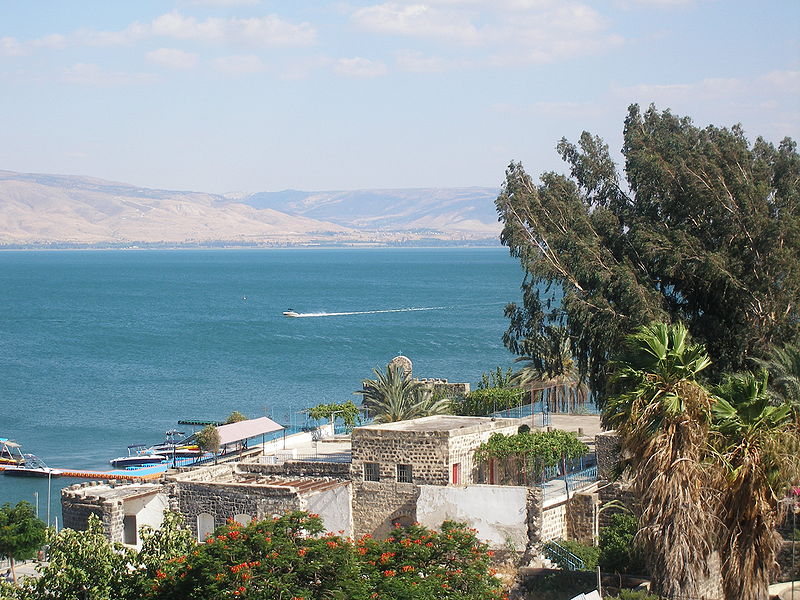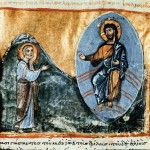
I have been on the road lately, and will be for a while yet, first with my family on vacation and later with my youth group mission trip. On top of that I’ve had the dreaded summer cold, so I’ve found my time and energy very short. Because of that, I’m going to combine two weeks of lectionary texts–the fourth and fifth Sundays after Pentecost–and I’m going to be more selective about the texts I treat. This might happen again soon, but hopefully as the summer wears on I can return to the full posts.
For this post, I’m going to look at two threads that pass through the lectionary texts for these two weeks. From the Hebrew Bible, we have two readings from 1 Samuel, detailing the life and adventures of David. From the Gospel of Mark, we have two texts that tell us interesting stories about Jesus and his interactions with those around him. I’m going to ignore the Psalms and the epistles, but there is some great stuff there too.
1 Samuel 17: 1a, 4-11, 19-23, 32-49 (text from the fourth Sunday after Pentecost)
What It’s About: This is the story of David and Goliath, one of the canonical stories of childhood, and probably familiar to anyone who spent time in a Sunday School classroom as a kid. It’s a story with that larger-than-life quality (see what I did there?), imbuing the biblical text with a mythical quality that wouldn’t be out of place in Middle Earth or Westeros. It’s the classic big-vs-small matchup, with dire odds for the small.
What It’s Really About: This is really our introduction to David in the flow of the canonical text. We meet him as a shepherd boy, a small person who is put into a big fight. Interestingly, the Hebrew Bible seems to preserve two different kinds of traditions about David’s origins: he’s a shepherd boy here, but he’s a talented musician elsewhere. Either way, we are to understand that David does not come from a place or strength, power, or the normal trappings of masculinity and martial ability. This functions to introduce us to David and to remind us that he is not the heir apparent to anything other than some sheep.
What It’s Not About: It’s not about obvious strength and power. The setup of this story is to pit overwhelming strength–that’s Goliath–against an upstart weakling with only his wits to help him. Of course, careful readers of the Hebrew Bible will know exactly what’s coming; the biblical text again and again lifts up weakness and futility as the marks of God’s favor. That David is presented as hopelessly outmatched should, by the time we get to 1 Samuel, be a sign that he will prevail, since we’ve already met younger sons usurping birthrights, tiny tribes and nations battling larger forces, and a people fleeing slavery under the world’s greatest imperial power. A shepherd boy up against an enormous warrior should tip us off; this shepherd boy is special.
Maybe You Should Think About: There is deep, deep anxiety in the church these days. Much of this anxiety has to do with the dawning realization that it is no longer Goliath. Once upon a time, the church was so enormous and powerful–financially, culturally, socially–that it could do whatever it wanted. But those days are ended, and the church finds itself looking more like David than Goliath these days. But this text tells a story with a message familiar to many a local congregation: there is great strength in being nimble, mobile, lean, and decisively strategic. How has the church changed as it has moved from being Goliath to being David? And how does it need to change some more?
2 Samuel 1:1, 17-27 (text from the fifth Sunday after Pentecost)
What It’s About: This is David’s lamentation for Saul, and, especially, Jonathan.
What It’s Really About: This text is hotly debated among those who have an interest (one way or another) in determining what the bible says or does not say about same-sex love. Some say that David’s words in verse 26, along with other bits of information about their relationship, imply that David and Jonathan were in some form of romantic relationship. Others say that David’s lamentation simply reveals a deep bond of friendship with Jonathan. In some ways, though, this discussion elides another one that is also worth having: here is a deep mourning text by and for people who by all accounts should have been enemies. This isn’t quite the Montagues and Capulets, but these two families did have some political animosities, and yet here is David mourning them in very ostentatious ways.
What It’s Not About: This seems to be, at the very least, something like that old saying in American politics that “politics ends at the water’s edge,” meaning that internal differences are not aired in front of foreign powers. Republicans don’t criticize Democrats in front of the Saudis, for instance–or at least that’s the story we like to tell about ourselves. Here we see a version of that. David makes a point of saying that people shouldn’t tell the residents of Gath (Goliath’s hometown!), because that would give them too much pleasure. David has just usurped Saul for the throne, and therefore he has taken Jonathan’s rightful place as king, but all that internal disagreement stops well short of the Philistines hearing anything about it.
Maybe You Should Think About: There are a couple of different angles on this one. You could preach the internal/external politics angle, or the forgiving your enemies angle, or the human sexuality angle. But whichever way you go, I really think this story deserves credit for giving us such tender insight into the feelings and allegiances of ancient people. David is clearly mourning here, and he is wounded. It’s remarkable that this kind of thing has come down to us, in such human dimensions.
Mark 4:35-41 (text from the fourth Sunday after Pentecost)
What It’s About: This is about Jesus calming the storm! And it is about the disciples’ continuing amazement and befuddlement at Jesus’ identity.
What It’s Really About: The Gospel of Mark has a complicated relationship with the Sea of Galilee. Recently, scholars have pointed out how much Mark owes (that’s a kind way of saying “borrows from,” which is a kind way of saying “copies”) Homer. Sea travel and its perils is certainly a large part of that. The Sea of Galilee is not a very large body of water, and it really doesn’t produce waves in the same way something like the Aegean would. But here, Mark has the Sea of Galilee (really a lake) play the part of a larger sea, with a tumultuous storm and terrifying waves. This is all so that Jesus can do the work of calming the storm, just by telling it to be still.
What It’s Not About: This story isn’t very flattering to the disciples. But then again, not much is in Mark’s gospel. After this mighty demonstration of power, all they can muster is a paltry “who is this guy?” The disciples’ ongoing obtuseness is a theme in Mark, and here it shows us that even after a great demonstration of power, they don’t really understand.
Maybe You Should Think About: Maybe think about strength and power in this story, in relationship to strength and power in the story of David and Goliath. Does weakness win both times? Why or why not?
Mark 5:21-43 (text from the fifth Sunday after Pentecost)
What It’s About: This is about two different stories that look unconnected at first, but upon closer inspection are told together because they interpret each other. The first is the story of the daughter of Jairus, the synagogue leader, who is sick and dying. The second story, embedded right into the middle of the first, is the story of an unnamed woman who struggles through a crowd to touch Jesus’ clothing.
What It’s Really About: Because people are increasingly aware that Mark was written first among the canonical gospels, there is a tendency to think of Mark as primitive. But Mark is not really very primitive at all; see, for example, his use of Homer referenced above. Here we see another bit of evidence for Markan artifice. These two stories are told together, and intertwined really, because telling them together increases the potency of each and helps us to interpret each. The story of Jairus’ daughter comes in verses 21-23 and 35-43, and the story of the woman with the flow of blood comes in the middle. And because the stories are structured this way, with clues like the number 12 left there for us in case we don’t get it the first time, we can read these two stories with more depth than we could if they were told apart.
What It’s Not About: Both stories are really interesting commentaries on agency. Whose agency heals the woman with the flow of blood, for instance? It’s hers, not Jesus’. And it is this girl’s father who pleads on her behalf, not her for herself. In the one story, Jesus heals almost by accident; in the other, Jesus heals a little bit too late for everyone’s comfort, but doing so conveys that he had it all under control the whole time. These two stories are really artful in the way that they are describing and playing with the questions of agency and control over Jesus’ power.
Maybe You Should Think About: What does the commonality of the number 12 (12 years with a flow of blood, and the girl is 12 years old) tell us? Are we to take that as a sign that they are linked? Is this woman the girl’s mother, ostracized since her birth after a hemorrhage? Is 12 fulfilling a symbolic function here? It’s not an accident that 12 shows up in both stories; Mark is being too artful for that. But what is it signaling to us?












